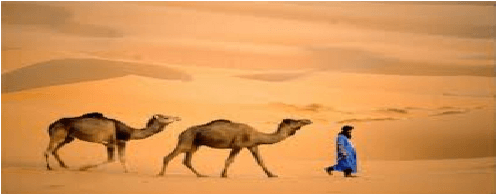Unit 9 lớp 12: Reading
Unit 9: Deserts
A. Reading (Trang 96-97-98-99 SGK Tiếng Anh 12)
Before you read (Trước khi bạn đọc)

- Work in pairs. Ask and answer the following questions. (Làm việc theo cặp. Hỏi và trả lời các câu hỏi sau.)
1. What do you know about deserts? (Bạn biết gì về sa mạc?)
=> Deserts are the large areas of sand without tree and water, but with severe climates, very hot during the day, and very cold at night. There is very little rainfall there; very few people and animals live except for in oases.
2. What kinds of plants and animals live in a desert? (Loại động thực vật nào sống ở sa mạc?)
=> In a desert, only cacti and a kind of spinifex can grow. No kind of animals can live in deserts.
3. Name some of the countries which have deserts. (Kể tên một số đất nước có sa mạc.)
=> Mexico, China, Australia, Mongolia, the USA and in North Africa ... have deserts.
While you read (Trong khi bạn đọc)
Read the passage and do the tasks that follow. (Đọc đoạn văn làm bài tập theo sau.)
Bài nghe:
Nội dung bài nghe:
Three great stretches of sandy desert almost circle the centre of Australia. To the north of Nullabor Plain stretches the Great Victoria Desert. In the west, the Gibbon, Great Sandy, and Tanami Deserts comprise an enormous sandy area. North of Lake Eyre lies the Simpson Desert, the last part of Australia to be explored.
The Simpson Desert lies between Lake Eyre in the south, the Macdonnel Ranges in the north, the Mulligan and the Diamantina Rivers in the east, and the Macumba and Finke Rivers in the west. The first European entered the Simpson Desert in 1845. But the desert remained a mystery until Madigan made an aerial survey in 1929. He named the desert after Simpson, President of the South Australian Branch of the Royal Geographical Society of Australia.
In 1936, Colson and an Australian Aborigine took camels across the desert. They travelled along the border of South Australia and the Northern Territory. Three years later Madigan led a scientific expedition across the sand dunes on a more northerly route. Colson and Madigan both travelled eastward across the Simpson Desert.
In the Simpson Desert there are different types of dunes. In the western part of the desert, there is a network of short dunes, mostly less than 10 metres high. Hummock grasses grow in loose sand on the crest and spinifex grows in the corridors between dunes and on the more stable slopes.
In the northern part of the desert, the dunes are parallel and separated by corridors of low, open shrubland. Spinifex grows on the slopes of the dunes. These dunes are deep red-brown, but the sand is pale in the area where Queensland, South Australia and Northern Territory meet. Dry salt lakes up to 70 kilometres long and 15 kilometres wide lie between long dunes with crests 20 metres high.
Hướng dẫn dịch:
Ba miền sa mạc lớn gần như bao quanh trung tâm nước Úc. Phía bắc đồng bằng Nullabor là sa mạc Great Victoria. Ở phía tây, sa mạc Gibbon, Great Sandy và Tanami tạo thành một vùng cát mênh mông. Phía bắc hồ Eyre là sa mạc Simpson, vùng đất cuối cùng ở Úc được khám phá.
Sa mạc Simpson nằm giữa hồ Eyre ở phía Nam, rặng Macdonnell ở phía bắc, sông Diamantina và Mulligan ở phía đông, sông Macumba và Finke ở phía tây. Vào năm 1845, người châu Âu đầu tiên đi vào sa mạc Simpson. Dù vậy, sa mạc này vẫn còn là điều bí ẩn cho đến khi Madigan thực hiện một cuộc trắc lượng trên không vào năm 1929. Ông đã đặt tên sa mạc là Simpson, theo tên vị Chủ tịch chi nhánh miền nam của Hội Địa lý Hoàng gia Úc.
Năm 1936, Colson và một thổ dân Úc cưỡi lạc đà băng qua sa mạc. Họ du hành dọc theo ranh giới giữa miền nam nước Úc và Hạt Bắc. Ba năm sau, Madigan tiến hành một cuộc thám hiểm khoa học băng qua các đụn cát theo một lộ trình lệch về phía bắc. Cả Colson lẫn Madigan đều đi về hướng đông băng qua sa mạc Simpson.
Trong sa mạc Simpson có rất nhiều đụn cát. Ở khu vực phía tây sa mạc là mạng lưới đụn cát thấp, phần lớn thấp dưới 10 mét. Cỏ đụn cát mọc ở phần cát xốp trên đỉnh, còn cỏ spinifex mọc ở hành lang giữa các đụn cát và trên những sườn núi vững chãi hơn.
Ở phía bắc sa mạc, các đụn cát song song nhau và được chia cách bởi các hành lang đầy cây bụi thấp và trống trải. Cỏ spinifex mọc trên sườn đụn cát. Các đụn cát ở đây thường có màu nâu đỏ thẫm, nhưng ở khu vực giữa Queensland, Nam Úc và Hạt Bắc thì cát có màu nhạt hơn. Các hồ nước mặn khô cạn dài đến 70 km và rộng đến 15 km nằm giữa những đụn cát cao đến 20 m.
Task 1. Give the Vietnamese equivalents to the following words or phrases. (Cho nghĩa tiếng Việt tương đương của những từ hay cụm từ sau.)
| 1. stretch: dài, trải | 6. dune: đụn cát |
| 2. sandy: có cát | 7. sloping: dốc thoải thoải |
| 3. aerial survey: trắc lượng trên không | 8. steep: dốc đứng, dốc ngược |
| 4. Royal Geographical Society of Australia: Hội địa lý Hoàng Gia Úc | 9. hummock: gò, đống |
| 5. Australian Aborigine: thổ dân Úc | 10. crest: đỉnh (gò/đống) |
| 11. spinifex: cỏ lá nhọn sống ở vùng sa mạc Úc |
Task 2. Decide whether the statements are true (T) or false (F). (Xác định xem các phát biểu sau là đúng (T) hay sai (F).)
Gợi ý:
| 1. F | 2. F | 3. T | 4. F | 5. F | 6. T |
Task 3. Answer the following questions. (Trả lời các câu hỏi sau.)
1. What are the names of the three great stretches of sandy desert which circle the centre of Australia? (Tên của 3 miền sa mạc lớn bao quanh trung tâm nước Úc?)
=> They are Great Victoria, Gibbon, Great Sandy, Tanami Deserts and Simpson Desert.
2. Where is the Simpson Desert? (Vị trí của sa mạc Simpson?)
=> It lies between Late Eyre in the south, the Macdonnel Ranges in the north, the Mulligan and the Diamantia Rivers in the east, and the Macumba and Finke Rivers in the west.
3. When did the first European enter the desert? (Người châu Âu đầu tiên đi vào sa mạc là khi nào?)
=> In 1845.
4. Who was Simpson? (Simpson là ai?)
=> He was the President of the South Australian Branch of the Royal Geographical Society of Australia.
5. How did E. A. Colson and an Australian Aborigine travel across the desert? (E. A. Colson và một thổ dân Úc đã du hành qua sa mạc bằng cách nào?)
=> They took camels across the desert.
6. What are the dunes like in the western and northern parts of the desert? (Những đụn cát ở khu vực phía tây và phía bắc của sa mạc trông như thế nào?)
=> In the western part, they are short, mostly less than 10 meters high, and in the northern part, they are paralell and up to 20 meters high.
7. How many kinds of grass grow in the Simpson Desert? What are they? (Có bao nhiêu loại cỏ mọc trong sa mạc Simpson? Đó là những loại cỏ nào?)
=> Two. They are hummock grasses and spinifex.
After you read (Sau khi bạn đọc)
Read this story and answer the questions that follow. (Đọc câu chuyện này và trả lời các câu hỏi theo sau.)
Hướng dẫn dịch:
Một phiên dịch người Việt đang dùng bữa tối với một doanh nhân người Mỹ trong một nhà hàng. Bữa tối rất ngon và cả hai đều cảm thấy rất ngon miệng. Vào cuối bữa, người phiên dịch hỏi vị doanh nhân "Ông muốn dùng gì để tráng miệng ạ?". Ngẫm nghĩ, vị doanh nhân đáp "Cây và nước".
1. Is the story funny? (Câu chuyện có buồn cười không?)
=> Yes, it is.
2. Where is the fun? (Điều buồn cười ở đâu?)
=> The interpreter mispronounced the word "dessert" (tráng miệng), and that made the businessman misunderstood that the interpreter was talking about "desert" (sa mạc).
desert /ˈdezət/ : sa mạc dessert /dɪˈzɜːt/ : món tráng miệng
Xem thêm các bài soạn, giải bài tập Tiếng Anh lớp 12 Unit 9 khác:
Xem thêm tài liệu giúp học tốt môn Tiếng Anh lớp 12 hay khác:
Đã có app VietJack trên điện thoại, giải bài tập SGK, SBT Soạn văn, Văn mẫu, Thi online, Bài giảng....miễn phí. Tải ngay ứng dụng trên Android và iOS.
Theo dõi chúng tôi miễn phí trên mạng xã hội facebook và youtube:Nếu thấy hay, hãy động viên và chia sẻ nhé! Các bình luận không phù hợp với nội quy bình luận trang web sẽ bị cấm bình luận vĩnh viễn.
- Giải Tiếng Anh 12 Global Success
- Giải sgk Tiếng Anh 12 Smart World
- Giải sgk Tiếng Anh 12 Friends Global
- Lớp 12 Kết nối tri thức
- Soạn văn 12 (hay nhất) - KNTT
- Soạn văn 12 (ngắn nhất) - KNTT
- Giải sgk Toán 12 - KNTT
- Giải sgk Vật Lí 12 - KNTT
- Giải sgk Hóa học 12 - KNTT
- Giải sgk Sinh học 12 - KNTT
- Giải sgk Lịch Sử 12 - KNTT
- Giải sgk Địa Lí 12 - KNTT
- Giải sgk Giáo dục KTPL 12 - KNTT
- Giải sgk Tin học 12 - KNTT
- Giải sgk Công nghệ 12 - KNTT
- Giải sgk Hoạt động trải nghiệm 12 - KNTT
- Giải sgk Giáo dục quốc phòng 12 - KNTT
- Giải sgk Âm nhạc 12 - KNTT
- Giải sgk Mĩ thuật 12 - KNTT
- Lớp 12 Chân trời sáng tạo
- Soạn văn 12 (hay nhất) - CTST
- Soạn văn 12 (ngắn nhất) - CTST
- Giải sgk Toán 12 - CTST
- Giải sgk Vật Lí 12 - CTST
- Giải sgk Hóa học 12 - CTST
- Giải sgk Sinh học 12 - CTST
- Giải sgk Lịch Sử 12 - CTST
- Giải sgk Địa Lí 12 - CTST
- Giải sgk Giáo dục KTPL 12 - CTST
- Giải sgk Tin học 12 - CTST
- Giải sgk Hoạt động trải nghiệm 12 - CTST
- Giải sgk Âm nhạc 12 - CTST
- Lớp 12 Cánh diều
- Soạn văn 12 Cánh diều (hay nhất)
- Soạn văn 12 Cánh diều (ngắn nhất)
- Giải sgk Toán 12 Cánh diều
- Giải sgk Vật Lí 12 - Cánh diều
- Giải sgk Hóa học 12 - Cánh diều
- Giải sgk Sinh học 12 - Cánh diều
- Giải sgk Lịch Sử 12 - Cánh diều
- Giải sgk Địa Lí 12 - Cánh diều
- Giải sgk Giáo dục KTPL 12 - Cánh diều
- Giải sgk Tin học 12 - Cánh diều
- Giải sgk Công nghệ 12 - Cánh diều
- Giải sgk Hoạt động trải nghiệm 12 - Cánh diều
- Giải sgk Giáo dục quốc phòng 12 - Cánh diều
- Giải sgk Âm nhạc 12 - Cánh diều




 Giải bài tập SGK & SBT
Giải bài tập SGK & SBT
 Tài liệu giáo viên
Tài liệu giáo viên
 Sách
Sách
 Khóa học
Khóa học
 Thi online
Thi online
 Hỏi đáp
Hỏi đáp

